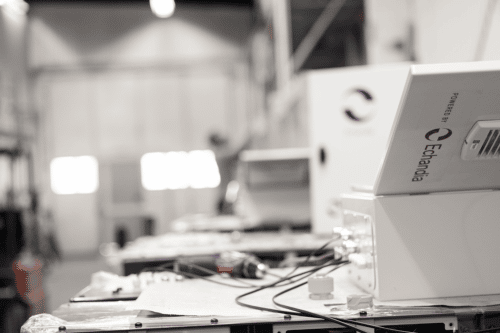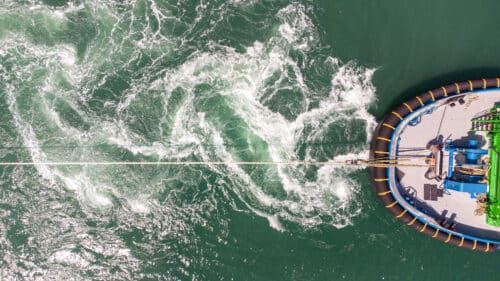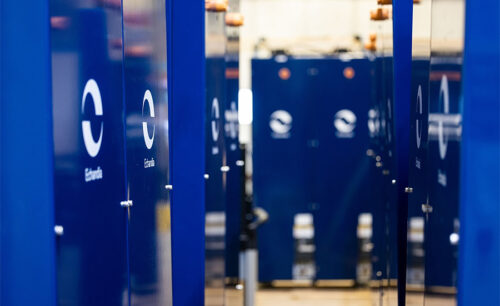

KMRL manager Sajan P. John on choosing LTO for the world’s largest fleet of electric vessels
- Insights
- 17 January 2022
The Kochi Water Metro project will be the largest fleet of electric vessels in operation, connecting 38 terminals and 10 islands. The idea of a water metro in Kochi evolved in 2016. The commissioning of the project was initiated about a year ago and has now finalized its first delivery of the first batch of 23 vessels with up to 55 more to come.
It’s an initiative to learn from and be inspired by. Many technical and engineering challenges has been overcome, to build and integrate the LTO battery systems on the vessels, with charging stations along the route.
We got the chance to talk to one the key people inside the project, to understand more of the reasoning, evaluation process and challenges. Following is an interview with Sajan P. John, General Manager at Kochi Metro Rail Ltd (KMRL).
Why did you choose LTO battery systems for the Inland Waterways Project?
There were many reasons. The inland water ways project at Kochi, otherwise known as Kochi Water Metro is an integrated water transport project in the southern state of Kerala of Indian peninsula. It utilises the backwaters of the city of Kochi, to revamp the vintage system of urban water transport. As a sustainable solution, the challenge was to design boats most suitable for the shallow and narrow waterways, still achieving a reasonable speed, which is critical in a transport modal shift back to waterways. This put a large constraint on the size of the vessel and its displacement. Every kilogram of weight added to the vessel is a challenge in itself.
Obviously, battery system has to be light and enduring besides primary requirement of safety in a passenger boat. No one like to carry a potential bomb under her belly, when they are transporting passengers on board. We found safest of all available lithium chemistry was LTO.
Planned to operate at a span of 16 hours a day, in such a size of boat, going for battery power with sufficient power stored, stretched for such longer operation is next to impossible with any battery chemistry. Especially when there are higher hotel loads due to air conditioning needs on a tropical climate. Kochi Water Metro thus adopted “opportunity charging” as its best suited operating philosophy. Endurance was ideally fixed as one hour of operation, to contain the battery size and thus the most critical aspect of all, the weight.
However, this posed fresh challenges. Battery requires a recharge at least 12 cycles a day, i.e., 4000 cycles a year. And each of the charging to be completed in the shortest time. Then we were looking at a life span of say, 7 to 10 years with these severe operating conditions, without compromises.
Our search ended up in LTO among the only feasible option in the world market. It can accept up to 10 C charging; easily attain a life of 32,000 charging cycles in the proposed band of bulk charging range, keeping the bank size the minimum.
Prior to making this choice, did you consider using other battery types? If so, which ones, and why did you ultimately not choose them?
Yes, from the beginning we knew, Lithium batteries are the choice. But which one out of many lithium chemistries was a question to be answered. Comparison was made between LiFeO4, NMC chemistries and of course, LTO. Claims from different makers and integrators were evaluated on the requirements of safety, adaptability (on the ambient conditions), durability, CAPEX (capital expenditure) and life cycle cost on the basic premises of the operating philosophy opted. LTO was a clear winner overall.
We additionally engaged classification society DNV to evaluate our findings utilising their expertise and experience. DNV was the first to come out with a BATTERY Notation and had ample experience. Their recommendations were clear too, and endorsed in favour of LTO.
Your eco-friendly boats have a number of sustainable features. How will these features work together with the LTO batteries to reduce overall emissions?
The concept of Water Metro evolved in 2016. Kochi Water metro planned to operate 78 vessels, 38 terminals over a stretch of 76 route kilometres integrating with other modes of transport connecting over 10 islands of Kochi.
In an environmentally sensitive area, going for a traditional diesel propulsion for such a vast project is a next to disaster. As early as first quarter of 2017, we had decided on moving to electric, though there were very little examples around the globe, in particular, in organised water transport system of considerable size, no experience.
Typical to developing countries cost control is another task, which had to go hand in hand, that made the design options tougher. In a cost analysis, though for LTO the unit cost is high, the lot size required comes much less, that offsets the difference in CAPEX largely. In a life cycle cost analysis, LTO was a clear winner.
Recycling is still an issue with batteries, but the longer lifecycle, less the concern.
We have targets for a net zero energy concept, where the complete requirement of electric power would be available from Solar PV installations. That means, that when the system is fully operational, we will not spend a penny on fuel or energy.
The terminals will have feeder services, ideally electric. It is envisaged that these feeder services also would receive energy from renewable sources. This is perfectly in alignment with the Faster adoption of Electric vehicle Policy of Govt. of India.
The vessels are all adapted for persons with disabilities, a first of its kind in water transport in India. A passenger control system, which restricts and regulates the number of passengers boarding the vessel is another innovative aspect, (important in Indian perspective of overcrowding possibilities) that would be incorporated in the centrally monitored operating control system.
With limited resources and technology, and the vast requirement of a totally integrated system, it took a slightly longer to launch the project. Then the Covid pandemic related logistics crisis had a delaying effect; but it is happening early 2022, with the first boat already delivered and next lot of 4 boats delivery scheduled in early 2022, after which the regular operations are expected to start.
What do you envision for a recharging schedule?
The longest of routes takes about an hour of sailing. There shall be fast chargers at both end of such routes. When it is shorter routes, the boats may return to its base within this period for a recharge. Battery size was decided on a recharging cycle from 20% to 80% of SoC, in the bulk charging range, to minimise the time for recharge.
Ideally, this happens around 15 minutes, while passengers alight/ board on the terminals. In the morning, batteries would be charged to 100% to start with, which would help in overcoming the busy peak hour requirements of higher turn in easily.
Instead of going for a custom made solution, we have decided on to adapt to Electric Vehicle (EV) chargers using CCS protocol which is used worldwide and a matured technology. There are cost benefits as well in adapting to technologies which already moved into mass production mode.
What would you tell other transit agencies who are considering using LTO but aren’t sure if it will meet all of their requirements?
Well, there is an argument that the battery technology is evolving and costs keep coming down, and so going for cheaper options and replacing it in future is economical solution. However, a temporary solution would be a compromise on many other fronts. With your goals set, and analysis done, go for the best solution, which at present is, LTO as per our firm belief, at least in a similar project.
To lean more about the project, take a look at this project presentation from KMRL


